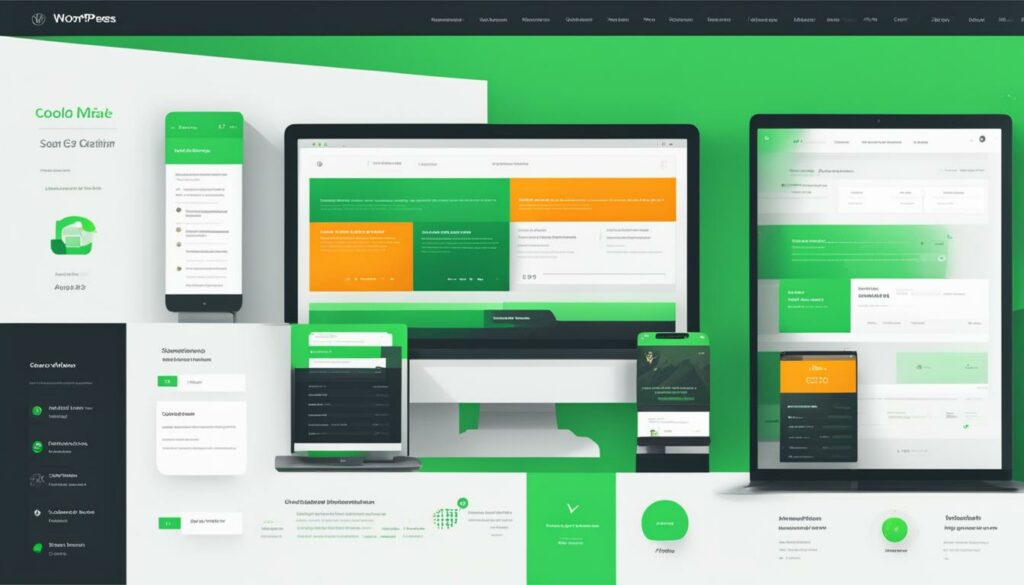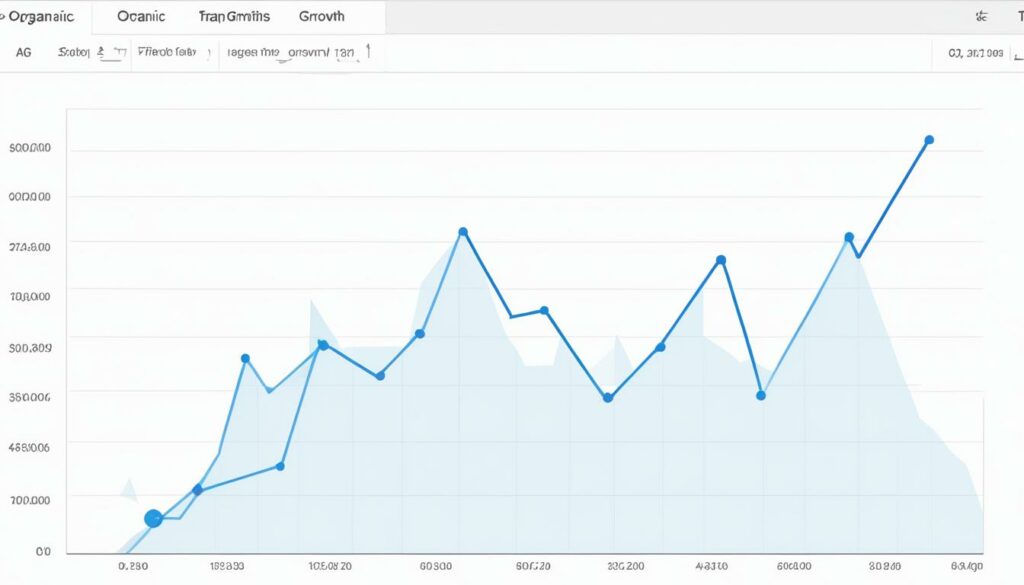In this article, we will explore the best practices for optimizing your WordPress site for search engines. By implementing effective SEO strategies, you can improve your website’s visibility and rankings on search engine results pages (SERPs). Investing in WordPress SEO is crucial for attracting more organic traffic and staying ahead of your competition.
When it comes to search engine optimization (SEO), WordPress sites have a competitive advantage. WordPress is a powerful content management system (CMS) that offers various tools and plugins to enhance your website’s SEO performance.
Key Takeaways:
- Optimizing your WordPress site for SEO is essential to improve visibility and rankings on search engine results pages (SERPs).
- Investing in effective SEO strategies can attract more organic traffic and help you stay ahead of your competition.
- WordPress provides a range of tools and plugins to enhance your website’s SEO performance.
- By implementing SEO best practices, such as optimizing your content and improving website speed, you can achieve long-term online success.
- Monitor your SEO metrics using tools like Google Analytics to track performance and refine your strategy accordingly.
We recommend WordPress Hosting from BoostedHost for optimal performance. Sign up now through this link.
Understanding SEO and Its Importance
SEO, or search engine optimization, is the process of optimizing your website to improve its visibility and rankings on search engines like Google. It plays a crucial role in driving organic traffic to your site, increasing brand awareness, and boosting conversions. By implementing effective SEO strategies, you can enhance your online presence and stay ahead of your competitors.
SEO involves various techniques and strategies to optimize your website’s structure, content, and online reputation. Keyword research helps you identify the terms and phrases your target audience is using to search for products or services. Content optimization ensures your website’s pages are relevant, valuable, and easily discoverable by search engine algorithms.
“SEO is the key to unlocking your website’s full potential and reaching your target audience.”
On-page SEO focuses on optimizing individual web pages, including factors like meta tags, headings, and URLs. Off-page SEO involves building high-quality backlinks and managing your online reputation through social media engagement and online directory listings.
Investing in SEO is vital because it helps your website appear higher in search results for relevant queries. Studies show that websites on the first page of search results receive the majority of clicks, making it essential to improve your rankings. Higher visibility and increased organic traffic further lead to improved brand credibility and authority.
“Don’t let your website get lost in the vast digital landscape. Stand out with SEO and reap the benefits.”
| Benefits of SEO | Why Your Website Needs SEO |
|---|---|
| Increased organic traffic | Improve search engine rankings |
| Higher brand visibility | Drive targeted traffic to your site |
| Better user experience | Outperform your competitors |
| Higher conversion rates | Establish brand credibility and authority |
Optimizing your website for search engines requires time, effort, and ongoing monitoring. However, the benefits of a well-executed SEO strategy are well worth the investment. Stay tuned for the next section where we will explore the basics of WordPress SEO and how to optimize your site for search engines.
The Basics of WordPress SEO
To optimize your WordPress site for SEO, there are a few essential steps you need to take. These include checking your visibility settings, customizing your permalink structure, and implementing XML sitemaps. Let’s take a closer look at each of these aspects:
Visibility Settings
One of the first things you should do when setting up your WordPress site is to ensure that search engines can crawl and index your content. To do this, navigate to the “Settings” menu in your WordPress dashboard and click on “Reading.” Make sure the checkbox next to “Discourage search engines from indexing this site” is unchecked. This allows search engines to access and index your site, improving its visibility.
Permalink Structure
Customizing your permalink structure is crucial for creating search engine-friendly URLs. A well-structured URL can enhance the user experience and make it easier for search engines to understand the content of your pages. To modify your permalink structure, go to the “Settings” menu and click on “Permalinks.” Choose a structure that includes relevant keywords and is easy to read.
XML Sitemaps
Implementing XML sitemaps can help search engines discover and index all the pages on your website more effectively. XML sitemaps act as a roadmap for search engine bots, ensuring that they can easily navigate through your site. To generate an XML sitemap, you can use a plugin like Yoast SEO or All in One SEO Pack. These plugins automatically generate XML sitemaps and keep them updated whenever you make changes to your site.
By taking these basic steps in WordPress SEO, you can lay a solid foundation for optimizing your site and improving its visibility in search engine results.

Boost your WordPress site’s SEO performance with the right tools and hosting. We recommend WordPress Hosting from BoostedHost. Sign up now for optimal performance!
Choosing an SEO Plugin
Enhance your WordPress SEO efforts by choosing a reliable SEO plugin. When it comes to WordPress SEO plugins, two popular options that stand out are Yoast SEO and All in One SEO Pack. These plugins offer a range of features to help you optimize your website for search engines and improve your rankings.
Yoast SEO is a comprehensive WordPress SEO plugin known for its user-friendly interface and powerful optimization tools. It provides an array of features, including on-page optimization guidance, XML sitemap generation, social media integration, and more. With Yoast SEO, you can easily optimize your content and ensure your website follows best SEO practices.
All in One SEO Pack is another top choice for WordPress SEO. It offers similar features to Yoast SEO, such as XML sitemap creation, title tag optimization, and social media integration. All in One SEO Pack is known for its simplicity and efficiency, making it a preferred option for many WordPress users.
Ultimately, the decision between Yoast SEO and All in One SEO Pack depends on your specific needs and preferences. Both plugins have their unique strengths, so consider factors like user-friendliness, feature set, and compatibility with your website when making your choice.
“Choosing the right SEO plugin is essential for optimizing your WordPress site. It can streamline the optimization process and improve your search engine rankings. With plugins like Yoast SEO and All in One SEO Pack, you have powerful tools at your disposal to enhance your website’s visibility and attract more organic traffic.”

| Plugin | Key Features |
|---|---|
| Yoast SEO |
|
| All in One SEO Pack |
|
Optimizing Your Content for SEO
When it comes to WordPress SEO, content optimization is a critical component of success. By conducting thorough keyword research, you can identify the most relevant and high-converting keywords to target in your content. Incorporating these keywords naturally and strategically throughout your pages and posts can significantly improve your website’s visibility in search engine results.
But it’s not just about keyword placement. You need to ensure that your content is engaging, informative, and valuable to your audience. Here are some content optimization tips to help you boost your WordPress site’s SEO:
- Keyword Research: Start by conducting keyword research using tools like Google Keyword Planner or SEMrush. Identify keywords that are relevant to your business and have a good search volume. Choose a mix of long-tail and short-tail keywords to target.
- Natural Keyword Incorporation: Once you have your target keywords, incorporate them naturally throughout your content. Avoid keyword stuffing, as it can negatively impact your SEO. Focus on creating informative and well-written content that provides value to your readers.
- Headings and Subheadings: Use headings (H1, H2, H3) to structure your content and make it easier to read. Incorporate your target keywords in these headings to signal search engines about the relevance of your content.
- Internal Linking: Implement internal linking by linking to relevant articles or pages within your website. This helps search engines understand the structure and hierarchy of your website while providing users with a seamless navigation experience.
- Meta Tags Optimization: Optimize your meta tags, including title tags and meta descriptions, to make them more compelling and search engine-friendly. These tags provide a summary of your content and appear in search engine results, so make them engaging and relevant to attract clicks.
Remember, creating high-quality, keyword-optimized content is essential, but it’s equally important to focus on providing value to your audience. By producing content that is informative, engaging, and optimized for search engines, you’ll be well on your way to boosting your WordPress site’s SEO performance.

Looking for WordPress Hosting that ensures optimal performance for your SEO efforts? BoostedHost offers reliable and high-performance WordPress Hosting plans. Sign up now to supercharge your website’s SEO performance!
Enhancing User Experience and Site Speed for SEO
User experience and site speed are two crucial factors that can greatly impact your website’s SEO performance. By prioritizing site speed and optimizing your website’s performance, you can improve user satisfaction, increase organic traffic, and boost your search engine rankings.
Optimizing Website Performance
To enhance your site’s speed and overall performance, consider implementing the following strategies:
- Minimize CSS and JavaScript Files: Reduce the size of your CSS and JavaScript files by eliminating unnecessary code and consolidating multiple files into a single file.
- Enable Browser Caching: Enable browser caching to allow returning visitors to load your site faster by storing static resources locally.
- Content Delivery Network (CDN): Utilize a CDN to distribute your website’s content across multiple servers worldwide, ensuring faster loading times regardless of the user’s location.
Image Optimization
Images play a significant role in enhancing your website’s visual appeal and engaging users. However, unoptimized images can negatively impact site speed. Follow these image optimization best practices:
- Compress Images: Use image compression tools to reduce the file size of your images without compromising image quality.
- Optimize Alt Text: Add descriptive and keyword-rich alt text to your images to improve accessibility and provide search engines with relevant information.
“Improving your website’s speed not only benefits your SEO efforts but also enhances the overall user experience. Users are more likely to stay and engage with your site when it loads quickly, reducing bounce rates and increasing conversions.”
Implement SSL (Secure Sockets Layer)
Implementing SSL on your website is essential for security, user trust, and SEO. SSL provides a secure and encrypted connection between your website and its visitors. Benefits of SSL include:
- Data Protection: SSL ensures that user data, such as passwords and credit card details, are protected from potential hackers.
- Trust and Credibility: Having an SSL certificate improves user trust as it verifies your website’s authenticity.
- Search Engine Ranking: Search engines prioritize websites with SSL, leading to potential SEO advantages.
Enhancing user experience and optimizing site speed through these strategies can significantly improve your site’s SEO performance. Prioritize these optimizations to create a faster, more secure, and user-friendly website.
Leveraging Off-Page SEO Strategies
While on-page SEO is crucial for optimizing your WordPress site, off-page SEO plays an equally important role in improving its visibility and rankings on search engine results pages (SERPs). Off-page SEO involves strategies that take place outside of your website but contribute to its overall SEO performance. By incorporating off-page SEO techniques like link building and social media engagement, you can enhance your site’s credibility and attract more organic traffic.
To boost your off-page SEO efforts, one essential technique to focus on is link building. Link building involves obtaining high-quality backlinks from authoritative websites to increase your site’s domain authority and improve its search engine rankings. When other reputable sites link to yours, search engines view it as a vote of confidence, indicating that your content is valuable and trustworthy. This, in turn, leads to improved visibility and organic traffic.
Social media engagement is another important factor that contributes to off-page SEO. By actively participating on popular social media platforms such as Facebook, Twitter, and Instagram, you can build a strong online presence and increase brand awareness. Engage with your audience by sharing valuable content, responding to comments and messages, and promoting your website’s content. This not only helps you connect with your target audience but also attracts more traffic to your site.
To understand the significance of off-page SEO strategies like link building and social media engagement, consider the following:
“Off-page SEO is like a vote of confidence from other websites and users. It shows search engines that your site is trustworthy and worth ranking higher.”
In summary, off-page SEO techniques such as link building and social media engagement are crucial for improving the visibility and rankings of your WordPress site. By obtaining high-quality backlinks and actively engaging with your target audience on social media platforms, you can enhance brand awareness, attract organic traffic, and improve your overall SEO performance.
Mobile Optimization for SEO
Mobile optimization is crucial for SEO, as the majority of internet users access websites from mobile devices. In fact, according to Statista, the number of mobile phone users worldwide is expected to reach 7.26 billion by 2023. To ensure your WordPress site ranks well in mobile search results and provides an optimal user experience, follow these mobile optimization best practices:
1. Ensure Mobile-Friendly Design
Make sure your website is mobile-friendly and responsive, meaning it adapts to different screen sizes and devices. Responsive design allows your site to maintain its functionality and visual appearance across various platforms, including smartphones and tablets.
“A mobile-friendly and responsive website ensures that users can navigate and interact with your content seamlessly, no matter the device they are using.”
When designing your site, consider the following mobile-friendly elements:
- Optimized font sizes for easy reading on smaller screens
- Clickable elements (buttons, menus, links) that are touch-friendly and easily accessible
- Easy-to-use navigation with a clear and concise menu structure
- Condensed forms and input fields to minimize typing on mobile
2. Optimize Website Performance
Website speed is crucial for both user experience and search engine rankings. According to Google, the probability of a user bouncing increases by 32% as page load time goes from 1 second to 3 seconds. To optimize your site’s performance:
- Optimize and compress images to reduce file size and improve loading speed. Consider using tools like TinyPNG for image compression.
- Minify CSS and JavaScript files to reduce their file size and improve loading times. Tools like Minifier can automatically remove unnecessary code.
- Enable browser caching to store website data on visitors’ devices, reducing the amount of data that needs to be loaded each time a user visits your site.
- Consider using a content delivery network (CDN) to serve your website’s content from servers located closer to your users, improving overall performance.
3. Optimize Content for Mobile
When creating and optimizing content for mobile devices, keep the following tips in mind:
- Break up text into easily scannable paragraphs to enhance readability on smaller screens.
- Use clear and concise headings to guide users through your content.
- Ensure important information and calls-to-action are placed prominently and are easily visible without excessive scrolling.
- Optimize meta tags, including title tags and meta descriptions, to provide concise and compelling summaries for search engine result pages (SERPs).
4. Test and Monitor
Regularly test your website’s mobile optimization using tools like Google’s PageSpeed Insights or Mobile-Friendly Test. These tools provide insights and recommendations for improving your site’s mobile performance.
“Continuous testing and monitoring will help you identify any issues or areas for improvement to ensure your website remains optimized for mobile devices.”
Additionally, regularly review your website analytics to track key metrics such as mobile traffic, bounce rate, and conversion rate. These insights will help you understand how users are interacting with your site and identify any areas that need attention.
To further enhance your mobile optimization efforts, consider utilizing a reliable WordPress hosting service, like BoostedHost, that offers specialized WordPress hosting for optimal performance. Sign up now through this link.
By following these mobile optimization best practices, you can create a mobile-friendly and responsive website that not only improves your search engine rankings but also provides a seamless user experience for your mobile visitors.
Measuring SEO Success and Analytics
Measuring and analyzing your website’s SEO performance is essential for understanding the effectiveness of your SEO efforts and making data-driven decisions. By utilizing tools like Google Analytics, you can track various SEO metrics to gain valuable insights and optimize your website’s performance.
Track SEO Metrics with Google Analytics
Google Analytics is a powerful tool that provides in-depth insights into your website’s performance. It allows you to track key SEO metrics such as:
- Organic traffic: Monitor the amount of traffic coming from search engines, which indicates the effectiveness of your SEO efforts.
- Bounce rate: Measure the percentage of visitors who leave your site after viewing only one page. A high bounce rate may indicate poor user experience or irrelevant content.
- Conversion rate: Track the percentage of website visitors who complete a desired action, such as making a purchase or submitting a form. This metric helps assess the effectiveness of your conversion optimization efforts.
- Keyword rankings: Monitor how your website ranks for specific keywords in the search engine results pages (SERPs). Tracking keyword rankings helps you identify areas for improvement and refine your SEO strategy.
By regularly monitoring and analyzing these SEO metrics, you can gain valuable insights into the performance of your website and make data-driven decisions to improve your SEO strategy.
Visualizing SEO Metrics with Website Analytics
In addition to Google Analytics, there are other website analytics tools available that can provide further insights into your SEO performance. These tools offer customizable dashboards, visualizations, and reports to help you understand the impact of your SEO efforts.
Here is an example table illustrating how website analytics can visually represent key SEO metrics:
| SEO Metric | Definition | Visual Representation |
|---|---|---|
| Organic Traffic | The number of visitors coming to your website from organic search results. | |
| Bounce Rate | The percentage of visitors who leave your site without interacting with it. | Visualization of bounce rate trends over time. |
| Conversion Rate | The percentage of visitors who complete a desired action on your website. | A chart showing the conversion rate for different marketing channels. |
| Keyword Rankings | Your website’s position in the SERPs for specific keywords. | A line graph displaying keyword ranking improvements or fluctuations. |
With these visual representations of SEO metrics, you can easily identify trends, patterns, and areas for improvement, allowing you to refine your SEO strategy and achieve better results.
Remember, measuring SEO success and analyzing website analytics is an ongoing process. Continuously monitor your SEO metrics, identify key performance indicators, and make data-driven decisions to optimize your website’s visibility and rankings on search engine results pages.
Conclusion
Implementing SEO best practices on your WordPress site is crucial for improving its visibility, attracting organic traffic, and boosting your search engine rankings. By following the strategies outlined in this article, such as optimizing your content, improving website speed, and leveraging off-page SEO techniques, you can enhance your WordPress site’s SEO performance and achieve long-term success online. Remember to monitor your SEO metrics and continuously refine your strategy to stay ahead of the competition.
For optimal performance and seamless WordPress SEO integration, we recommend WordPress Hosting from BoostedHost. Their hosting solutions are specifically designed to enhance your WordPress site’s speed, security, and overall performance. Sign up now through this link: www.boostedhost.com/wordpress-hosting and take your WordPress site to new heights of success.
By embracing WordPress SEO best practices and implementing the most effective optimization strategies, you can ensure that your website is fully equipped to rank higher in search results, attract more organic traffic, and meet the demands of today’s competitive online landscape. Start implementing these strategies today and unlock the full potential of your WordPress site!
FAQ
Q: What is SEO and why is it important for WordPress sites?
A: SEO, or search engine optimization, is the process of optimizing your website to improve its visibility and rankings on search engines. It is important for WordPress sites because it helps your website appear higher in search results, attracting organic traffic and boosting your online presence.
Q: What are the basics of WordPress SEO?
A: The basics of WordPress SEO include checking your visibility settings, customizing your permalink structure, and implementing XML sitemaps to ensure that search engines can easily crawl and index your site.
Q: Which SEO plugin is recommended for WordPress sites?
A: Two popular SEO plugins for WordPress are Yoast SEO and All in One SEO Pack. These plugins offer features like on-page optimization, XML sitemap generation, and social media integration to simplify the process of optimizing your site for search engines.
Q: How can I optimize my content for SEO?
A: To optimize your content for SEO, conduct keyword research to identify relevant keywords. Incorporate these keywords naturally throughout your pages and posts, implement internal linking, and optimize your meta tags, such as title tags and meta descriptions.
Q: How can I enhance user experience and site speed for SEO?
A: Improve your site’s speed by optimizing performance, minimizing CSS and JavaScript files, enabling browser caching, and using a content delivery network (CDN). Optimize images to reduce file size, and consider implementing SSL for a secure and encrypted connection.
Q: What are some off-page SEO strategies I can use?
A: One important off-page SEO strategy is link building, obtaining high-quality backlinks from authoritative websites. Another strategy is social media engagement, actively participating on social media platforms to increase brand awareness and drive traffic to your website.
Q: Why is mobile optimization crucial for SEO?
A: Mobile optimization is important because the majority of internet users access websites from mobile devices. Ensure your WordPress site is mobile-friendly and responsive, optimizing design, layout, and navigation for a seamless mobile experience.
Q: How can I measure SEO success and analytics?
A: Utilize tools like Google Analytics to track SEO metrics such as organic traffic, bounce rate, conversion rate, and keyword rankings. By monitoring these metrics, you can make data-driven decisions and continuously refine your SEO strategy.












